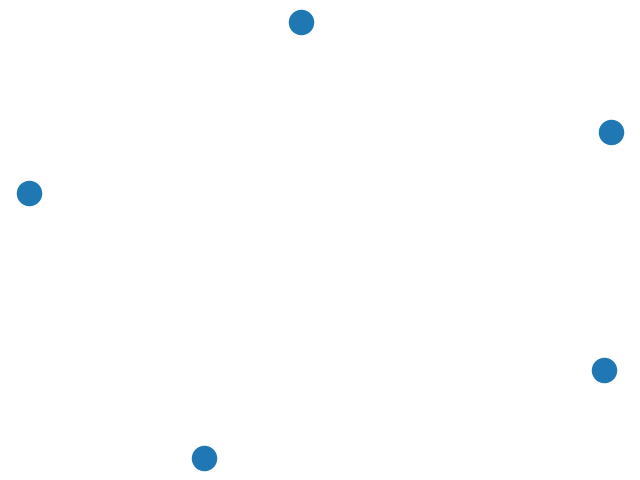empty_graph#
- empty_graph(n=0, create_using=None, default=<class 'networkx.classes.graph.Graph'>)[source]#
Returns the empty graph with n nodes and zero edges.
(
Source code,png)
- Parameters:
- nint or iterable container of nodes (default = 0)
If n is an integer, nodes are from
range(n). If n is a container of nodes, those nodes appear in the graph.- create_usingGraph Instance, Constructor or None
Indicator of type of graph to return. If a Graph-type instance, then clear and use it. If None, use the
defaultconstructor. If a constructor, call it to create an empty graph.- defaultGraph constructor (optional, default = nx.Graph)
The constructor to use if create_using is None. If None, then nx.Graph is used. This is used when passing an unknown
create_usingvalue through your home-grown function toempty_graphand you want a default constructor other than nx.Graph.
Notes
The variable create_using should be a Graph Constructor or a “graph”-like object. Constructors, e.g.
nx.Graphornx.MultiGraphwill be used to create the returned graph. “graph”-like objects will be cleared (nodes and edges will be removed) and refitted as an empty “graph” with nodes specified in n. This capability is useful for specifying the class-nature of the resulting empty “graph” (i.e. Graph, DiGraph, MyWeirdGraphClass, etc.).The variable create_using has three main uses: Firstly, the variable create_using can be used to create an empty digraph, multigraph, etc. For example,
>>> n = 10 >>> G = nx.empty_graph(n, create_using=nx.DiGraph)
will create an empty digraph on n nodes.
Secondly, one can pass an existing graph (digraph, multigraph, etc.) via create_using. For example, if G is an existing graph (resp. digraph, multigraph, etc.), then empty_graph(n, create_using=G) will empty G (i.e. delete all nodes and edges using G.clear()) and then add n nodes and zero edges, and return the modified graph.
Thirdly, when constructing your home-grown graph creation function you can use empty_graph to construct the graph by passing a user defined create_using to empty_graph. In this case, if you want the default constructor to be other than nx.Graph, specify
default.>>> def mygraph(n, create_using=None): ... G = nx.empty_graph(n, create_using, nx.MultiGraph) ... G.add_edges_from([(0, 1), (0, 1)]) ... return G >>> G = mygraph(3) >>> G.is_multigraph() True >>> G = mygraph(3, nx.Graph) >>> G.is_multigraph() False
See also create_empty_copy(G).
Examples
>>> G = nx.empty_graph(10) >>> G.number_of_nodes() 10 >>> G.number_of_edges() 0 >>> G = nx.empty_graph("ABC") >>> G.number_of_nodes() 3 >>> sorted(G) ['A', 'B', 'C'] ----
Additional backends implement this function
cugraph : GPU-accelerated backend.